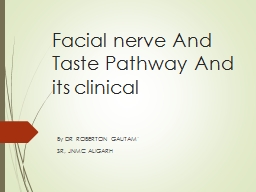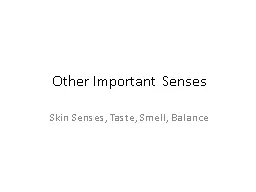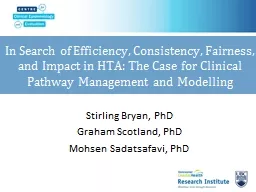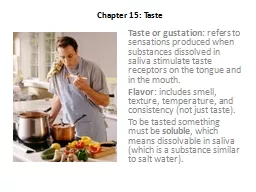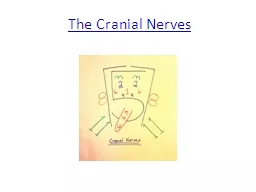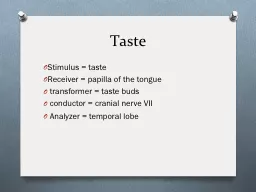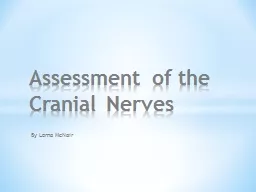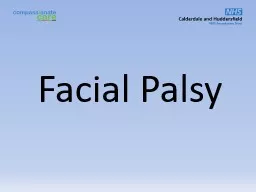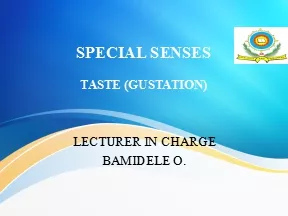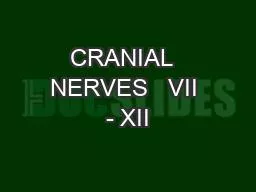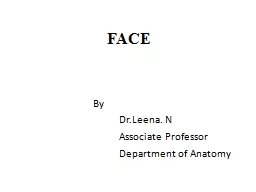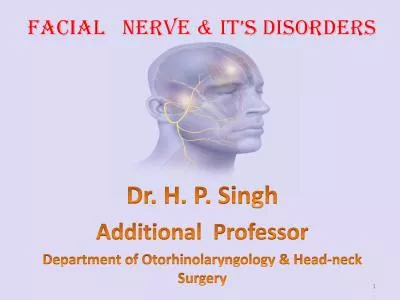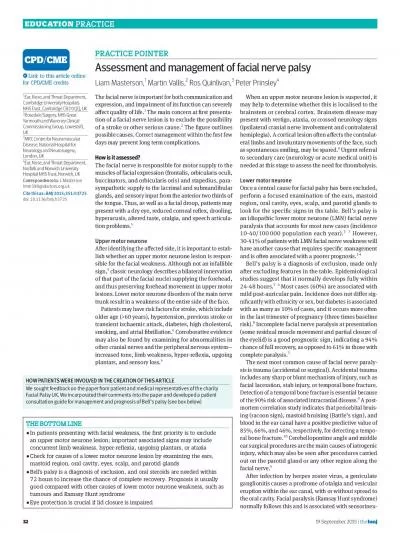PPT-Facial nerve And Taste Pathway And its clinical
Author : isabella2 | Published Date : 2023-07-21
By DR ROBERTON GAUTAM SR JNMC ALIGARH Functional Components In addition to having similar somatic and visceral components as spinal nerves some cranial nerves also
Presentation Embed Code
Download Presentation
Download Presentation The PPT/PDF document "Facial nerve And Taste Pathway And its ..." is the property of its rightful owner. Permission is granted to download and print the materials on this website for personal, non-commercial use only, and to display it on your personal computer provided you do not modify the materials and that you retain all copyright notices contained in the materials. By downloading content from our website, you accept the terms of this agreement.
Facial nerve And Taste Pathway And its clinical: Transcript
By DR ROBERTON GAUTAM SR JNMC ALIGARH Functional Components In addition to having similar somatic and visceral components as spinal nerves some cranial nerves also contain special sensory and motor components . lacrimation. . and watery nasal discharge accompanied by . sneezing.. She had a severe . attack one spring morning that was accompanied by respiratory difficulty . and she was admitted to hospital. She received the proper treatment and her condition improved. On examination she had bilateral nasal obstruction by . Skin Senses, Taste, Smell, Balance. Touch. Sense . of touch is a mix of four distinct skin . senses . pressure. warmth. cold. pain. Skin Senses: Touch. Physical stimuli = mechanical, thermal, and chemical energy impinging on the . Stirling Bryan, PhD. Graham Scotland, PhD. Mohsen Sadatsafavi, . PhD. Overview of session. Stirling Bryan:. In Search of Efficiency, Consistency, Fairness, and Impact in . HTA. Graham Scotland. Modelling screening and treatment pathways for diabetic retinopathy. gustation. : . refers to sensations produced when substances dissolved in saliva stimulate taste receptors on the tongue and in the mouth. . Flavor:. includes smell, texture, temperature, and consistency (not just taste).. . Cranial nerves are spinal nerves that come out of the brain instead of the spinal cord.. Cranial Nerves. . Cranial nerves are spinal nerves that come out of the brain instead of the spinal cord.. Receiver = papilla of the tongue . . transformer = taste buds . . conductor = cranial nerve VII. . Analyzer = temporal lobe . Touch . Stimulus = . pain, pressure, temperature . Receiver = . skin . D. An unpleasant sensory and emotional experience associated with actual or potential tissue damage , or described in terms of such damage. Pain is always subjective. PAIN. What do we associate to?. Dental and Periodontal Pathology. Why should this concern Dentists?. Trigeminal Nerve . (CNV) gives . sensory. innervation to . mouth, face. , and scalp so disease affecting this nerve can cause sensory loss and/or . orofacial. pain. This N. also gives . Speech. Eat/ drink. Eye protection. Relationships. Self image. Recreation and work. Symmetry…… . Smile & Eyes. What is Facial Palsy?. Facial. paralysis resulting from a dysfunction of the cranial nerve VII (the . LECTURER IN CHARGE. BAMIDELE O.. . INTRODUCTION. The sense of taste (gustation) affords an animal the ability to evaluate what it eats and drinks.. At the most basicl level, this evaluation is to promote ingestion of nutritious substances and prevent consumption of potential poisons or toxins.. Cranial Nerve VII: Facial. Fibers leave the pons, travel through the internal acoustic meatus, and emerge through the . stylomastoid. foramen to the lateral aspect of the face. Motor functions include facial expression, and the transmittal of autonomic impulses to lacrimal and salivary glands. . N . Associate Professor . Department of Anatomy . FACE. Extents. Superiorly from the adolescent position of hairline,. Inferiorly to the chin and the base of the mandible, and. Each side to the . 1 ❖ The facial nerve contains approximately 10,000 fibers. ❖ 7000 myelinated fibers innervate the muscles of facial expression, stapedius muscle, postauricular muscles, posterior belly of dig 32 | the bmj When an upper motor neurone lesion is suspected, it may help to determine whether this is localised to the brainstem or cerebral cortex. Brainstem disease may present with vertigo
Download Document
Here is the link to download the presentation.
"Facial nerve And Taste Pathway And its clinical"The content belongs to its owner. You may download and print it for personal use, without modification, and keep all copyright notices. By downloading, you agree to these terms.
Related Documents

